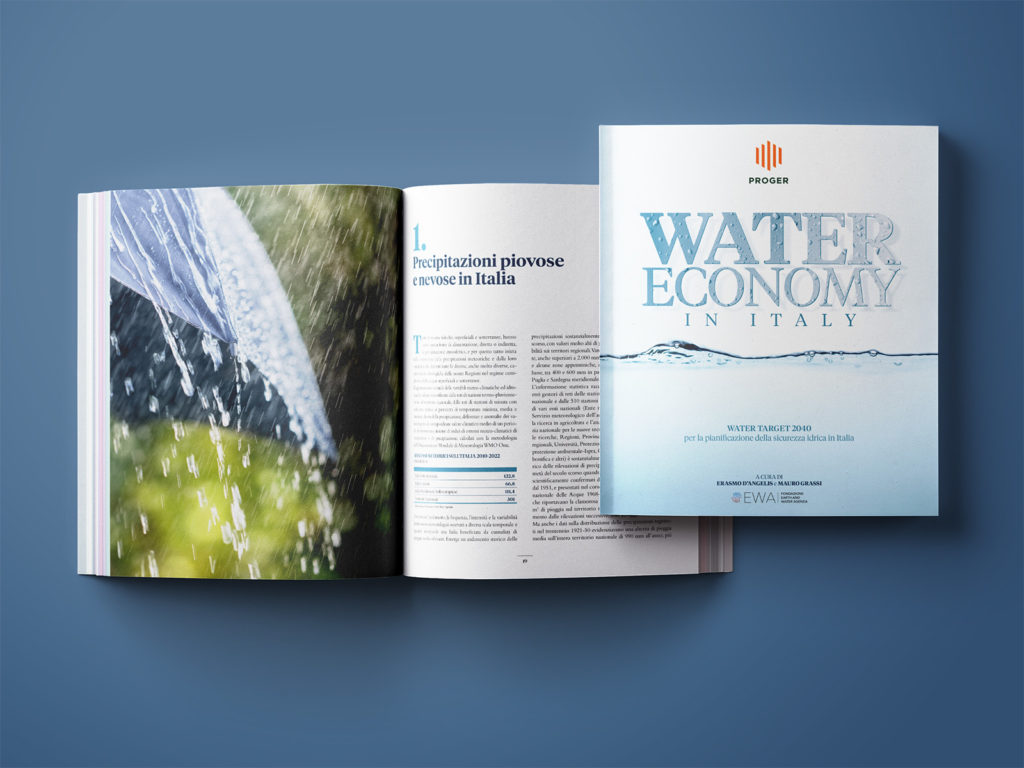Water Economy in Italy
The first report to provide an organic overview of water resources in Italy

Proger Observatory on the Infrastructures of the Future decided to start its work with a study on the water economy, complete with an analysis of deficits and investment needs in infrastructure and technology in all sectors of use
The Water Economy report, produced by Proger with the collaboration of the Earth and Water Agenda Foundation, is the first study to provide a complete and detailed picture of the water resource in Italy: quantity, withdrawals, uses, infrastructures and needs, examined in relation to the necessary adaptation to climate change. A complete and articulate reflection on the absolute priority of safeguarding water in the country’s strategic choices.
Italy is living with the hydrogeological threat and water scarcity despite lacking the natural conditions to maintain the balance between water demand and availability. Rainfall in Italy is abundant: on a national scale it records 301 billion m3 of rainfall on average, but only 11% of rainfall is withdrawn for all uses. Our country ranks 5th in Europe for average rainfall, Milan is the rainiest metropolitan area in Europe and Rome is wetter than London.
Italy has more rain than Holland or Germany,
yet the peninsula is at risk of drought
due to a lack of infrastructure.
Considering Italy’s rainfall and water resources, the average annual theoretically usable water withdrawal is five times higher for all uses (civil, agricultural industrial). The problem is that rainfall is not evenly distributed throughout the year, and the same areas that are victims of bad weather waves and floods then have to deal with a lack of water in the warmer months. A phenomenon that has a common denominator: the lack of water infrastructure to manage and use water when and where it is needed.
Water stress impacts agriculture,
tourism and industry with damages
estimated in the order of 20 billion euro
between 2000 and 2022.
4.8 million Italians live in code red flood risk areas. We are a fragile country: of the total number of landslides recorded in Europe, more than 80% concern Italy
Italy is basically stuck at the same reservoir capacity as half a century ago, but with greatly increased needs and consumption. There are 531 large dams whose reservoir capacity would be 13.652 billion m3, but actual volumes are 35% lower (due to delays in technical-functional testing procedures, progressive silting due to lack of drainage, and lack of new investments).
After floods, drought is the second most costly natural hazard. Between 2000 and 2022, Italy was hit by severe droughts with total damage between agriculture, food, industry, and energy amounting to 20 billion euro.
Italy pays €165,000 per day to the EU
as a penalty for infringements
related to the lack of wastewater
purification and reuse systems.
A sieve network: almost 40% of the drinking water withdrawn does not reach the taps. To make matters worse, there is no price signal: we have the lowest average tariff in Europe (€176.16 average consumption for a family of three), which does not discourage overconsumption.
Italy pays €165,000 a day in fines to the EU (about 60 million a year) as a result of various infringements in the area of water infrastructure. In particular, the lack of water purification and filtering systems for wastewater, both agricultural and industrial, and its reuse, even in the civil sector.
In addition, Italy’s water balance should also be considered from a historical perspective: we are the country that invented aqueducts and irrigation systems, we are great implementers of land reclamation, and we boast the excellence of national companies specialised in dams and reservoirs, which, however, work almost exclusively abroad where they are highly valued.
In conclusion, the report presented by Proger examines the necessary step change to secure water resources for civil, agricultural and industrial uses and to generate clean energy. A resumption of investment (public and private), changes in legislation and governance, and a technical, design and entrepreneurial effort are required to increase storage capacity; to replace and regenerate networks and plants, and to build new infrastructure; to reuse wastewater and recharge aquifers on a planned basis; to desalinate and utilise seawater; and to apply innovative and artificial intelligence-based technologies that ensure the saving and control of the resource.